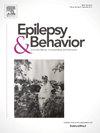Temporal lobe encephaloceles: Electro-clinical characteristics and seizure outcome after tailored lesionectomy
IF 2.3
3区 医学
Q2 BEHAVIORAL SCIENCES
引用次数: 0
Abstract
Objective
Our study aimed to investigate the management of patients with medically refractory epilepsy related to temporal encephaloceles, focusing on the use of ancillary testing in the pre-surgical evaluation to optimize surgical outcomes.
Methods
We conducted a retrospective analysis of electronic medical records from the Cleveland Clinic, covering the period from January 2000 to May 2020. Patients with drug-resistant temporal lobe epilepsy were included if they had temporal lobe encephaloceles and required surgical intervention. We reviewed the results of ancillary studies, including invasive EEG.
Results
A total of 19 patients with temporal lobe encephaloceles underwent resection for drug-resistant epilepsy treatment. Among them, 63 % reported experiencing auras commonly associated with mesial temporal lobe epilepsy, such as autonomic, psychic, and abdominal symptoms, followed by dialeptic seizures. Ictal patterns were consistently ipsilateral, with high amplitude delta or medium amplitude theta activity at onset, predominantly localized to the frontotemporal region in more than half of the cases. In 35 % of these patients, encephaloceles were only diagnosed during surgery. Stereo-EEG evaluation revealed two distinct ictal patterns: one characterized by localized low voltage fast activity in the temporal pole evolving into a 3–4 Hz high amplitude diffuse spiky activity, and the other exhibiting low amplitude rhythmic theta activity in the temporal pole with late involvement of the amygdala/hippocampus. Surgical resection strategy was based on clinical history and ancillary data analysis. At one-year follow-up after resection, 63 % of the patients attained Engel I seizure control over an average duration of 44 months (ranging from 6 months to 7.3 years). Additionally, 18 % of the patients achieved an Engel II outcome.
Significance
Tailored resection of the encephalocele and the surrounding temporal pole, while preserving the mesial temporal structures, can effectively control seizures in patients with temporal encephaloceles identified through MRI. Patients presenting with temporal lobe symptoms and scalp ictal patterns characterized by polymorphic high delta theta activity with frontotemporal evolution should be evaluated for temporal encephaloceles as a potential underlying cause of their seizures, especially when the MRI is otherwise unrevealing.
颞叶脑瘤:量身定制的病灶切除术后的电临床特征和癫痫发作结果。
研究目的我们的研究旨在调查与颞叶脑瘤相关的药物难治性癫痫患者的管理情况,重点关注手术前评估中辅助检查的使用情况,以优化手术效果:我们对克利夫兰诊所 2000 年 1 月至 2020 年 5 月期间的电子病历进行了回顾性分析。耐药性颞叶癫痫患者如果患有颞叶脑瘤并需要手术治疗,我们将其纳入研究范围。我们回顾了包括侵入性脑电图在内的辅助研究结果:共有 19 名颞叶脑瘤患者接受了切除手术,以治疗耐药性癫痫。其中,63%的患者报告出现了与颞叶中叶癫痫常见的光环,如自主神经症状、精神症状和腹部症状,其次是透析性癫痫发作。ctal模式始终是同侧的,发病时有高振幅的delta或中等振幅的theta活动,半数以上的病例主要发生在额颞区。其中 35% 的患者在手术中才被确诊为脑瘤。立体电子脑电图(stereo-EEG)评估显示了两种不同的发作模式:一种是颞极局部的低电压快速活动演变为3-4赫兹的高振幅弥漫性棘波活动,另一种是颞极的低振幅节律性θ活动,晚期累及杏仁核/海马。手术切除策略基于临床病史和辅助数据分析。在切除术后一年的随访中,63%的患者在平均44个月(从6个月到7.3年不等)的时间内达到了恩格尔I型发作控制。此外,18%的患者达到了恩格尔II型:意义:在保留颞中叶结构的同时,对脑疝和周围颞极进行有针对性的切除,可有效控制通过磁共振成像发现的颞叶脑疝患者的癫痫发作。对于出现颞叶症状、头皮发作模式以多形性高δθ活动为特征并伴有额颞叶演变的患者,应将颞脑膜瘤作为其癫痫发作的潜在病因进行评估,尤其是在核磁共振成像无法揭示其他病因的情况下。
本文章由计算机程序翻译,如有差异,请以英文原文为准。
求助全文
约1分钟内获得全文
求助全文
来源期刊

Epilepsy & Behavior
医学-行为科学
CiteScore
5.40
自引率
15.40%
发文量
385
审稿时长
43 days
期刊介绍:
Epilepsy & Behavior is the fastest-growing international journal uniquely devoted to the rapid dissemination of the most current information available on the behavioral aspects of seizures and epilepsy.
Epilepsy & Behavior presents original peer-reviewed articles based on laboratory and clinical research. Topics are drawn from a variety of fields, including clinical neurology, neurosurgery, neuropsychiatry, neuropsychology, neurophysiology, neuropharmacology, and neuroimaging.
From September 2012 Epilepsy & Behavior stopped accepting Case Reports for publication in the journal. From this date authors who submit to Epilepsy & Behavior will be offered a transfer or asked to resubmit their Case Reports to its new sister journal, Epilepsy & Behavior Case Reports.
 求助内容:
求助内容: 应助结果提醒方式:
应助结果提醒方式:


